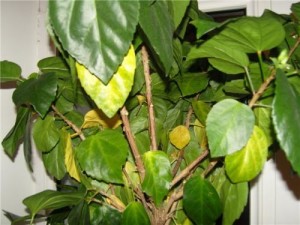
If the rose leaves turn yellow and fall off. Why the leaves of a rose turn yellow - all the reasons in detail.
Often, indoor plants that have been living in the same place for a long time suddenly start to get sick. At a room rose, the leaves fall and turn yellow for several reasons. Sometimes even experienced flower growers cannot accurately determine the factors that cause the disease. home rose very pretty and popular houseplant, but not many people have the opportunity to enjoy its lush flowering and growth due to the fact that the flower is rather capricious in growing and caring.
When purchasing such a plant, it is worthwhile to study in advance all the information about caring for it. It is more difficult when a flower was presented, and at first it looked great, but over time, its leaves turn yellow and fall off. For a beginner, it will not only be difficult to find out the cause of the disease, but also to understand how to deal with it. But everything is not so scary, if you are attentive to this beauty, then it is quite possible to return her to her former appearance and condition.
So, first you need to figure out what the causes of rose disease can be. There can be quite a few of them, and all of them are mainly associated with improper care, transplantation or lack of complementary foods.
Soil condition
Often the leaves of the flower turn yellow due to lack of moisture in the soil. Overdried land and the appearance of a crust with cracks on its upper layer is a sure sign of a lack of watering. It is worth noting that it is worth watering the rose regularly. The reference point should be the condition of the soil: if the substrate is moist and has no cracks, then it is too early to water. As a rule, an adult room rose bush requires watering two to three times a week, or even 10 days. In a hot and dry season, it is worth placing a humidifier in the room and watering more often than usual. One of the reasons why they begin to crumble and is watering with cold water. From this, the plant becomes ill, and over time it can stop growing and die. It is worth watering with settled and soft water, some experts recommend boiling it for watering.
The right substrate for a room queen of flowers is one of the most important conditions for its active growth and flowering. For transplanting, it is better to purchase a ready-made mixture specifically for roses, experts also advise a substrate for violets. When in the ground where there is not enough air and nutrients, the foliage may turn yellow at the shrub. To cope with such a problem can only be a complete replacement of the soil. By the way, you can prepare the earthen mixture necessary for this beauty yourself, for this you need to mix the following components:
- 1 part coarse river sand;
- 1 part charcoal;
- 4 parts of peat;
- 4 parts of sod land.
And, of course, do not forget about drainage, it is simply necessary for good growth and the healthy existence of a flower.
IT'S IMPORTANT TO KNOW!
You have already tried many WITH HYPERTENSION? If you continue to "knock down" the pressure with pills, after a while it returns again. Hypertension is the main culprit of strokes and hypertensive crises. Find out what the famous cardiologist Leo Bokeria advises so that your blood pressure is always 120/80...
Lack of fertilizer or incorrect feeding
The soil for this plant should contain a considerable amount of nutrients. Therefore, regular feeding of the flower is carried out. Often, the leaves of a room rose begin to turn yellow precisely for this reason. The lack of calcium and iron in the substrate is manifested precisely by the disease of the foliage. This can be determined exactly by the localization of yellow spots: the leaf begins to turn yellow in the space between the veins, then gradually the entire surface becomes light.
To solve this problem, you should immediately feed home flower, fertilizer should contain iron and calcium. Of course, it is better for the plant if the fertilizer is complex. It should be applied a week after transplantation, and in the usual mode - once every 3 weeks. Nitrogen deficiency also leads to leaf disease.
It is no secret that in flower shops and salons a certain temperature regime, air humidity level are observed and special top dressings are introduced for active flowering. When purchasing a rose, it is worth asking what conditions she is used to.

The most common answer to the question of why rose leaves turn yellow is poor acclimatization after changing growth conditions. It is worth remembering that you can not put a flower pot near heaters and batteries: from heat and dry air, not only leaves can fall off, but the bush itself can dry out. You can not place the plant on the windowsill on the sunny side. Direct exposure to sunlight leads to leaf burns, which can cause them to turn yellow or brown. Just like heat, cold is harmful to flowers. A rosette in winter should not be on a balcony or loggia; with the onset of cold weather, it is brought into a warm room.
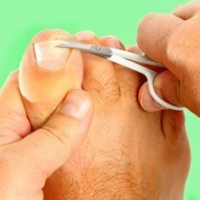
So, answering the question of why the leaves of a room rose turn yellow, there are several main reasons:
- illiterate plant fertilizer;
- improper watering, shrub care;
- unsuitable substrate for this type of flower;
- non-compliance with the temperature regime and the level of humidity in the room;
- various diseases inherent in this species.
In general, the factors can be different, the main thing is to correctly identify them and eliminate them in a timely manner. If you create the necessary conditions for a room rose, then it will not seem whimsical and capricious to you at all. Yet long years the flower will grow and delight the owners with its flowering and aroma.
And some secrets...
Have you ever experienced unbearable joint pain? And you know firsthand what it is:
- inability to move easily and comfortably;
- discomfort when going up and down stairs;
- unpleasant crunch, clicking not of their own free will;
- pain during or after exercise;
- inflammation in the joints and swelling;
- causeless and sometimes unbearable aching pain in the joints ...
Now answer the question: does it suit you? Can such pain be endured? And how much money have you already "leaked" for ineffective treatment? That's right - it's time to end this! Do you agree? That is why we decided to publish an exclusive interview with Professor Dikul, in which he revealed the secrets of getting rid of joint pain, arthritis and arthrosis.
Thanks to flowers, you can change a lot in your life, and this is true, but I will tell you how to do it somehow in the following articles. The information is really interesting and you should like it, but today we will talk about something else. Do you agree that when a plant looks beautiful, the mood rises, and when problems appear, the mood drops. Today we will talk about why the garden rose leaves turn yellow and dry, what could be the reasons and what to do about it. In fact, there can be a huge number of reasons for this phenomenon, and I will try to talk about them in detail.
In some cases, yellowing may begin due to physiological characteristics and this is not scary, and sometimes there are serious reasons that you need to do something about, otherwise you can lose your favorite plant.
Why do rose leaves turn yellow
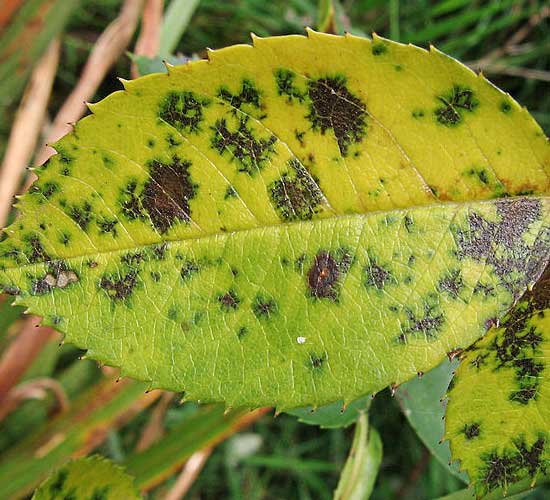
- Rose leaves turn yellow and fall off
Most often, rose leaves may turn yellow due to adverse external conditions. For example, this can happen due to a sharp change in temperature. In the summertime in our regions, this can happen, as the weather can often change. Although modern varieties garden roses adapted to such situations.
- Why do roses turn yellow lower leaves
If your queen's lower leaves have begun to turn yellow, then she probably does not have enough light. Perhaps your beauty is sitting somewhere in the shade and she is uncomfortable there.
Rosa loves sunny, sheltered places. Before planting roses, choose a location where the sun is plentiful in the morning. It is advisable to grow roses on the south or southeast side of the garden.
In the shade of a rose, not only the leaves begin to turn yellow. In such conditions, her shoots also stretch out and flowering may stop.
If your rose turns yellow and curls, the edges and tips of the leaves turn brown and dry, then the plant does not have enough water.
Roses are very difficult to tolerate lack of water. For this reason, their leaves turn yellow, dry and fall off, and the flowers begin to deform and fall off. As a result, flowering may stop. Especially in hot weather, climbing roses that grow near the wall of the house need.
Newly planted roses that have not had time to take root also need regular watering.
- Yellow spots appeared on the leaves of the rose
Yellow spots on the leaves may appear due to a lack of nutrients. The following signs also indicate a lack of nutrition:
- Slow plant growth.
- Poor resistance to various diseases and pests.
- The stems of such plants are weak.
- The lower leaves fall off.
- Flowering is weak, with small pale flowers, or absent altogether.
By the way the yellowing of the leaves occurs, you can determine what substance the plant lacks.
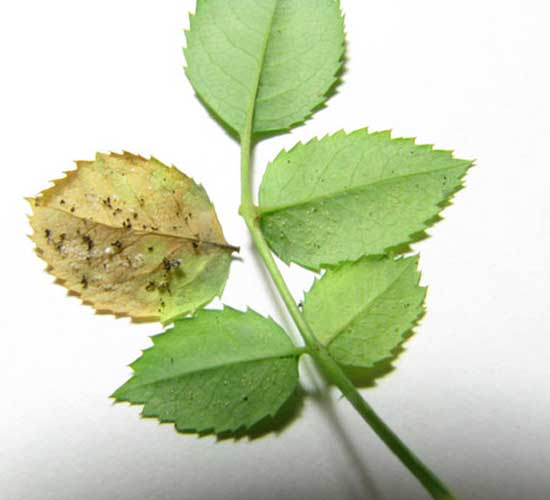
Old leaves turn yellow prematurely and yellowing starts at the top and spreads down the edges. Gradually the edges become brown.
- With a lack of calcium
With a lack of calcium, rose leaves become small, irregular in shape with edges bent down. Often, with a lack of potassium, light yellow spots appear on the leaves. The tops of the stems gradually turn white and die.
- iron deficiency
With a lack of iron in a rose, young leaves turn completely yellow, and old ones become covered with large yellow spots.
- Manganese deficiency
If the rose lacks manganese, then yellow stripes and small spots form on the leaves between the veins. The veins themselves remain green.
With a lack of nutrients, the rose is fed with the necessary elements, or complex fertilizers.
The leaves of the rose turned yellow due to pests, or due to illness.
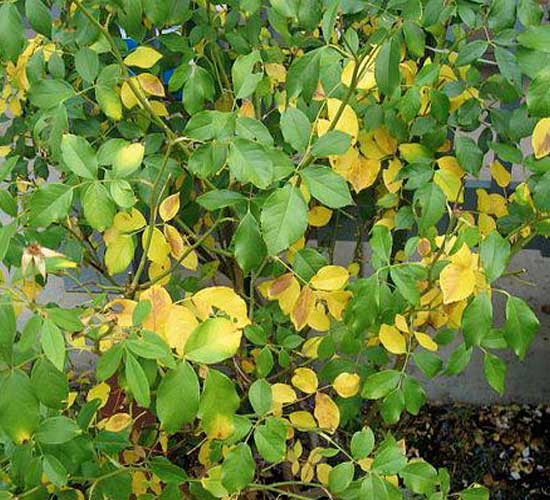
- black spot
Black spot is a very dangerous disease of roses. The disease affects the plant at the beginning of the summer season, and symptoms appear in the second half of summer.
First, small brown spots with yellow edges appear on the leaves. Then, the spots increase, turn yellow and fall off. The same spots cover not only the leaves, but also the stems. As a result, the plant loses its leaves, and flowering stops.
What to do
Unfortunately, it is very difficult to deal with black spot, therefore, efforts must be directed towards prevention. If the disease has already appeared, then the fight must begin at an early stage, removing all diseased leaves and spraying the plant with a decoction of horsetail.
If the disease has spread strongly, then the plant should be sprayed every 10 days with preparations that contain sulfur.
In autumn, the infected plant is sprayed with soapy copper sulphate.
In extreme cases, roses are sprayed with beard liquid every 7-10 days and water the soil around the bush with the same liquid. Such a measure is resorted to only as a last resort, if other means have not brought the desired result.
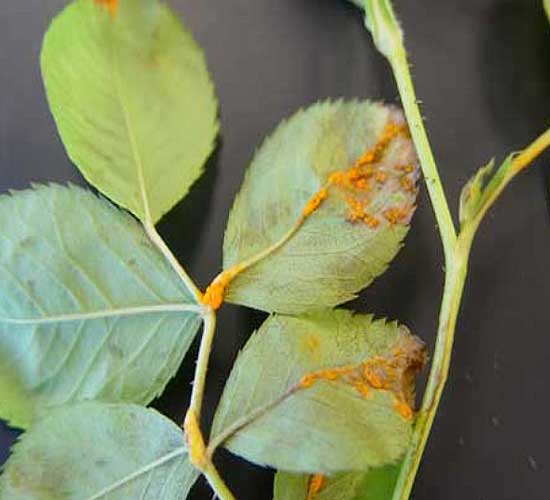
You can not even guess about the appearance of this infection for some time. The spider mite is a very small blood-sucking insect that can be seen when the number of mites becomes huge.
Ticks settle on the underside of the leaf and suck out its juices, as a result of which the leaves become covered with yellow speckles, and a cobweb appears on the bottom of the leaf and on the stems. Over time, the leaves turn yellow and fall off. Spider mites can appear due to too dry air.
What to do
First of all, you need to direct all your efforts to prevent the appearance of a tick. To do this, every day the plant is sprayed.
If ticks have already appeared, then the plant can be sprayed, washed with infusions of herbs, or garlic (onions).
To prepare an infusion of onions (or garlic), take 1 tsp. chopped onion or garlic, pour a glass of boiling water and leave for 24 hours.
It helps to get rid of the tick infusion of potato tops. To do this, take 1.2 kg. green tops (or 0.8 kg dry), pour water and infuse for 3-4 hours.
If the mite damage is severe, then you need to buy a special preparation in the store, dilute it as indicated in the instructions and treat the plant 2-3 times with an interval of 7-10 days.
- Rose leaves turn yellow due to aphids
Aphids are no less dangerous than spider mites, but they can be noticed more quickly, since the aphid is larger. In aphids, both adults and larvae are dangerous. The aphid not only sucks the juices from the plant, it also secretes a sticky liquid, which after a while becomes covered with a black moldy coating. Roses are most susceptible to attack by aphids before flowering.
When roses are affected by aphids, the leaves begin to curl and turn yellow, and the buds do not bloom, or become small and ugly.
To prevent aphids from spreading, it is advisable to plant rose bushes at some distance, and plant plants between the bushes, the smell of which repels aphids (lavender, nasturtium, etc.).
What to do when aphids appear 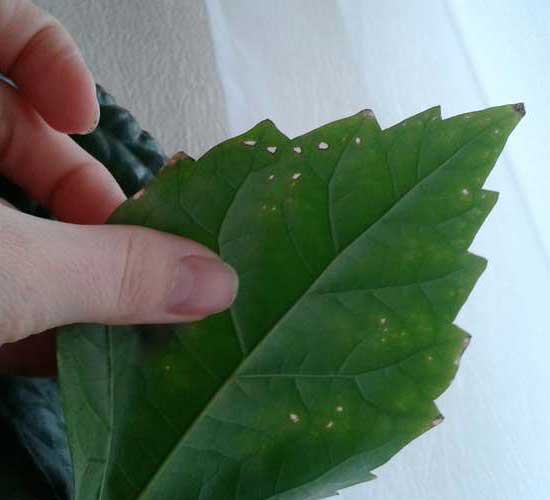
At the initial stage, you can do without the use of any drugs. It is enough just to cut off the affected leaves and destroy them.
If there are too many aphids, then the roses are treated with special solutions.
- rose scale
Scale insects mainly affect leaves, accumulating on the underside. The accumulation of scale insects looks like dandruff. In the process of life, scale insects suck the juices from the leaves, the leaves turn yellow and fall off. The plant is slowing down.
What to do
At the initial stage of the disease, damaged leaves are removed, or insects are removed with a wet cloth or toothbrush. Then the plant is treated with garlic - soapy water.
If you missed it and the shield has grown very much, then it is almost impossible to fight it, since it is covered with a protective shield.
- Nematode
The nematode infects the root system of the plant. As a result of the vital activity of the nematode, yellow spots appear on the leaves of the rose, which eventually turn brown and the leaves curl and fall off. The flowers become small and deformed.
What to do
Unfortunately, it is impossible to fight the nematode. In this case, there is only one remedy - the destruction of the diseased plant. After the plant is destroyed, plants are planted in its place that destroy the nematodes. These plants include calendula, or marigolds.
Well, that's all I wanted to talk about why rose leaves turn yellow and talked a little about what to do in some cases. I hope you have found answers to your questions in this article. I would be glad if you share your experience, tell me what you do when the rose leaves turn yellow.
Why does the indoor rose not bloom?
There may be several reasons for this.
- lack of lighting
Roses are photophilous plants, so they need to be kept on the southwest or southeast windows.
Windows that are directed to the south are not quite suitable for roses, because in summer the plants are very hot on them, which is why the flowers and leaves of the roses become smaller, and the flowers quickly fade and crumble.
Western and eastern windows are also suitable for keeping roses, but it is better not to put roses on windows that face the north side.
But if the windows in your apartment only face the north side, then you can create artificial lighting for roses.
Roses bloom beautifully under artificial lighting, so if there is not enough sunlight in the room, you can create artificial lighting in which roses will bloom just as well as in sunlight.
Therefore, if the plant does not bloom, then you should think about whether it has enough lighting.
It is also necessary to take into account the length of daylight hours, which should be at least 10-12 hours. Illuminating lamps turn on when it starts to get dark outside and leave them on until midnight. Lamps should be located at a distance of no more than 30 centimeters from the top of the roses.
At proper creation artificial lighting roses can bloom until winter. It is also necessary to take into account the fact that on sunny windows, especially in summer, the pots can become very hot under the sun, which leads to the drying of the earth, and the roots of the plants overheat.
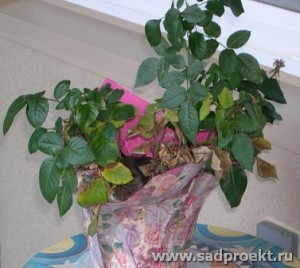 Roses are quite sensitive to such overheating, so for roses it is better to choose light-colored pots to avoid such overheating, and in the summer you should cover the walls of the pots from direct sunlight with white paper.
Roses are quite sensitive to such overheating, so for roses it is better to choose light-colored pots to avoid such overheating, and in the summer you should cover the walls of the pots from direct sunlight with white paper.
- Wrong soil
Indoor roses love soil with a neutral pH of 6.5-7.5. If the rose grows in soil with inappropriate acidity, it may not bloom or the flowering will be very sluggish. Therefore, if everything is in order with the lighting, then you should deal with the soil.
- Room temperature not suitable
Roses categorically do not tolerate drafts. Therefore, if you do not have the opportunity to find a place in the house without drafts, then you can make a small paper or linen screen near the plant at about half its height.
Very dry air can also be a reason why roses do not bloom. It should be noted that if the temperature in the apartment is more than 22 ° C, then periodic spraying of the plant will not be enough.
It is necessary to wash the rose leaves with water once a week. It is best to do this in the evening after sunset. You can also put water containers near the plant, it will evaporate and thereby humidify the air.
This is due not only to starvation of the plant or the fact that the plant has not been transplanted for several years and has not been fed, but also with an excess amount of fertilizer.
It is better to "underfeed" the plant somewhat than to salt the soil with fertilizers. The same can be said about the concentration of fertilizers: it is better to dilute the fertilizer than to burn the roots of the plant with a mixture that is too concentrated.
Incorrect transplantation is also one of the main reasons why a rose does not bloom.
This may be due to the fact that the flower pot is too cramped or too spacious, as well as damage to the roots during transplantation.
Transplanting roses in autumn or winter can also cause a lack of flowering, or even lead to the death of the plant.
- Pest infestation
This, oddly enough, is not the most common reason for the lack of flowering in roses. However, with a strong pest attack, the plant not only develops and grows poorly, but also does not form buds. If the pest has not yet had time to spread strongly on the plant, then it may well bloom, but subsequently the rose will begin to lose both buds and flowers.
Also, the rose may not bloom due to improper pruning.
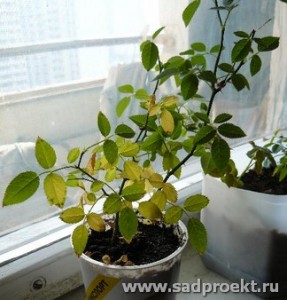 Why do rose leaves turn yellow?
Why do rose leaves turn yellow?
One or more of the above factors can cause rose leaves to turn yellow.
If there are no diseases and pests on the leaves of the plant, then the yellowing of the leaves of roses may be due to a lack of nutrients.
With a lack of nitrogen, rose leaves turn pale green from the midrib.
With a lack of iron, yellowness appears between the veins of the leaves. With a lack of potassium, spotting and yellowing of the leaves appear. Yellowing leaves on roses can also be due to excess fertilizer.
If you do not fertilize the rose in time, then abundant flowering can greatly deplete the plant, which will also lead to yellowing of the leaves. In this case, it is necessary to feed the plant with complex fertilizer. Also, to maintain immunity, you can additionally sprinkle the leaves with Silk or Epin.
To prevent the treatment of chlorosis (yellow spots on the leaves, yellowing of the leaves with green veins), the Iron Chelate fertilizer should be used. Spraying or watering infected plants with this drug should be carried out 2 times during the growth period and then every 2 weeks if necessary.
If the leaves of the rose have begun to turn yellow, then this should not be ignored, as this can lead to the drying of the plant.
Summing up, we can say that before embarking on a plan to save your plant, you should first analyze the conditions of detention and.
As you know, the rose is the queen of flowers. A queen must always look her best. Therefore, if suddenly the leaves of your room pet began to turn yellow, it is urgent to take measures to prevent this process. Otherwise, the queen risks losing her attractiveness and grandeur, and you are the most beautiful home flower.
But before you start fighting yellowed leaves, you should understand the cause of this phenomenon, because even if you get rid of all the leaves of a similar color and do not eliminate the root cause, you will soon have to do these movements again.
Causes of yellowing leaves in a room rose
The causes of yellowing of the leaves can be very diverse, for example, a burn from the sun's rays. The fact is that direct sunlight is destructive, not only for the leaves of a room rose, but also for its flowers. It is best to keep this plant near windows that are directed to the southwest or southeast.
But there are several more possible reasons why the leaves of a room rose begin to turn yellow:
- watering the plant with too cold water;
- overdried substrate;
- draft;
- overflow.
For normal life room rose just need fresh air. In this regard, in the summer, it is best to keep it either on the balcony or on the terrace. You can also take a flowerpot with a rose to a flower bed and dig it a little in the ground. If you live in an apartment and you don’t have such an opportunity, you can keep a rose and just next to open window while avoiding drafts. Thanks to such manipulations, a room rose can easily endure even the strongest sun.
We present to your attention several possible reasons for changing the color of the leaves of a room rose:
- if there are no pests on your room beauty, and she is not sick with anything, but her leaves turn yellow anyway, this may indicate that the plant lacks some nutrients;
- if the leaves of a room rose turn pale green, and turn yellow from the middle vein, this directly indicates a lack of nitrogen;
- yellowed leaves with spots are evidence of a lack of potassium. And if yellowing is visible between the veins of the foliage, it means that the plant lacks iron;
- interestingly, rose leaves can turn yellow even if the plant receives too many nutrients. In order to prevent this, it is necessary to adhere to the correct dosage of top dressing, which is indicated on the package;
- the plant should be fertilized on time, especially during the flowering period. The fact is that at this time the rose is very depleted and requires additional nutrition. If this is not done, the leaves of the plant will be yellow and lethargic, and the number of flowers will be insufficient;
- Another cause of yellow leaves may be chlorosis. The main signs of its presence are yellowing of the leaves, but with green veins, as well as yellow spots on green leaves. In order to fight this ailment, as well as to prevent the disease, you should use a water-soluble iron chelate fertilizer. They need not only to water the plant, but also to spray it.
Remember that another reason for the yellowing of the leaves of a room rose may be its incorrect transplantation. This plant needs to be transplanted once a year, preferably in February. This is done by transshipment, but with extreme caution so as not to damage the roots of the plant in any way. An already transplanted plant should be moved to a warmer place.
By the way, when transplanting a plant, it is necessary to change not only the soil, but also the pot. Every year, its diameter should increase by 2-3 centimeters.
rose diseases
 To begin with, I would like to note that indoor roses get sick only in two cases:
To begin with, I would like to note that indoor roses get sick only in two cases:
- They were purchased already infected.
- Due to improper care.
If the rose was bought "clean" and cared for properly, there is a huge chance that this indoor rose will show that its leaves are turning yellow, and even more falling off.
Nevertheless, do not forget about the most common diseases and pests that can affect this plant:
- powdery mildew;
- rust;
- spider mite;
- thrips.
And now we will tell you about how to determine the presence of a particular pest on a room rose, as well as what exactly can be its root cause.
Powdery mildew is expressed in a white coating, very similar to flour, which forms on the upper side of the foliage of a rose. If you do not get rid of it in time, then over time it will also appear on the buds, as well as the stems. The cause of powdery mildew is considered to be an excess of fertilizer, as well as a lack of fresh air.
Rust appears as tubercles at the base of young shoots. The reasons for its appearance are:
- plant overflow;
- too high temperature;
- lack of fresh air.
What a spider mite looks like is known to everyone. But few people know that the reasons for the emergence of this pest are the large crowding of plants and very warm and dry air.
If you plant rose bushes yourself, you take care of them because you want them to look good. One fine day, walking between them, we saw yellowing leaves, which did not really alarm you. But you should not ignore these symptoms even if there is no sharp fall and the leaves do not change color. Here's what you need to do to determine why the leaves are turning yellow, reverse the process, and prevent the bush from possibly dying.
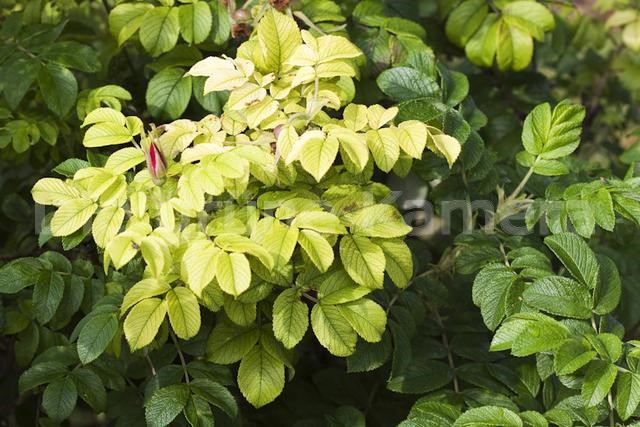 One of the most likely causes of yellow leaves is chlorosis. In general, chlorosis is caused by iron deficiency. This is especially common where the soil tends to increase in high calcium carbonate. Chlorosis is usually eliminated by tillage. Add 450-900 g of ferrous sulfate or sulfur per 30 sq. m. in one go, and then cover with a layer of mulch at least 10 cm thick. For immediate treatment, spray the leaves of your roses with a solution of ferrous sulfate containing 28-30 g of ferrous sulfate and 11 liters of water.
One of the most likely causes of yellow leaves is chlorosis. In general, chlorosis is caused by iron deficiency. This is especially common where the soil tends to increase in high calcium carbonate. Chlorosis is usually eliminated by tillage. Add 450-900 g of ferrous sulfate or sulfur per 30 sq. m. in one go, and then cover with a layer of mulch at least 10 cm thick. For immediate treatment, spray the leaves of your roses with a solution of ferrous sulfate containing 28-30 g of ferrous sulfate and 11 liters of water.
During the hottest days of summer, heat stress can also cause leaves to turn yellow. This is especially true after a wet and cool spring. This is common among newly planted rose varieties, as they have not had enough time to develop a good root system that is able to control the process of evaporation of moisture from the leaves. Evidence that heat stress is the culprit includes scorched leaf edges and dark petal edges during flowering. To treat heat stress, place a large layer of mulch around the roots and shorten branches to encourage root development. Make sure that the water penetrates deep enough, at least 0.6 m. This stimulates the growth of all roots, and shallow watering encourages the growth of small roots.
Waterlogging is another source of leaf yellowing in roses. soft, brown spots on the shoots, hanging mature leaves, and flowers that do not open fully are signs of excess moisture. The cure for this situation is to improve drainage by increasing the amount of organic matter in the soil and to replace any clay-like soils with loose garden soil.
You can add fertilizer over the soil like mulch to change it, but really the best and only effective way to amend the soil is to dig to a depth of about 30-60 cm (depending on the size of the root system of the bush) and mix with soil improvers. Obviously this will be a problem if your roses are already planted in soil that has poor drainage. Digging around roses is an acceptable solution. One way to check for poor drainage is to make a narrow hole about 20 cm long into which water is poured. If there is still water in the hole after an hour, you have a drainage problem.
When using a large amount of water-soluble fertilizer, yellow leaves can be the result of salt stress, nitrate accumulated by the plant from fertilizer. Salt stress also reduces plant growth and causes scorched edges on leaves. Treat salt stress by switching to organic fertilizers with a low salt index.